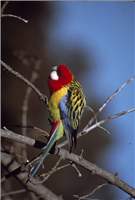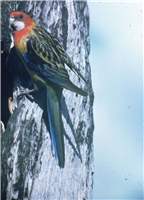Family
Psittacidae
Genus
Platycercus
Species
eximius
Threats/Control Methods - Regional
Eastern Rosellas compete for nesting hollows with other introduced birds of similar size, such as the Common Starling (Sturnus vulgaris ) and the Common Myna (Acridotheres tristis ). Domestic pets such as Cats (Felis catus) and Dogs (Canis familiaris) are also threatening to the birds when feeding, especially to young birds.
Threats/Control Methods - Local
Not currently thought to be at risk within the ACT although habitat change and introduced species may compete for habitat or predate upon the species.
Local/Urban Actions
It is quite easy to attract the species to urban backyards. Certain native plant species such as acacias, banksias and eucalyptus provide natural food sources and habitats. Artificial feeding, such as providing birdseed is not recommended, in part due to the attraction it provides for non-native bird species such as Rock Doves (Columba livia ). Rosellas will also use nest boxes successfully for breeding. An entrance diameter of 8cm and an inside diameter of 20cm is recommended in a vertical nest box with a side entrance at least 10m up. Ensure the nest box is visible and pest birds such as Common Mynas (Acridotheres tristis ) or Starlings (Sternus vulgaris) are not using it. Cat enclosures are an excellent possibility for pet owners wanting to enjoy the beautifully coloured birds feeding in their gardens without limiting the birds' chance of survival.
Common Names
Eastern Rosella, Redheaded or White-cheeked Rosella, Golden Mantle, Polly Parrot, Rosehill Parakeet, Rosy.
Distinguishing Features
Eastern Rosellas are medium-sized, very colourful parrots with distinctive white cheek patches. The head, neck and breast is red, the underbelly yellow and the rump is a yellow-green to blue-green, with a red undertail. The shoulders are bright blue. Females are slightly duller and young birds dull and can be aged by their bill colour, which changes from yellow or orange to off-white when mature.
Survey Techniques
Call and visual identification.
Species Call
A sharp repeated 'chut-chit-chut' in flight and a high-pitched 'pee-pt-eee' or 'kwink kwink' when perched.
Similar Species
The Eastern Rosella is similar to the Australian King Parrot (Alisterus scapularis ) and the Crimson Rosella (Platycercus elegans ) in size and shape but its markings, especially the red head and yellow chest, provide easy identification of this species.
Distribution
The Eastern Rosella is found across eastern Australia and TAS, across to SA in the south. They have been introduced into New Zealand.
Country of Origin
Australia
Conservation (Pet/Pest) Status - Regional
Unlike many of the other parrots, population numbers have stayed constant over the past 20 years (COG).
Conservation (Pet/Pest) Status - National
Secure, not listed under the EPBC Act 1999. However, the Tasmanian population Platycercus eximius diemenensis is currently listed as Near Threatened, as the population has almost halved in the last century.
LSCCES Population
Moderate values were recorded in ANU and Turner, while lower numbers were found in Civic West, CSIRO, NMA, Black Mt. and BMP.
Associated vegetation community
The Eastern Rosella is found in areas of open woodland, grassland, farmland and remnant bushland. In Canberra, the species prefers more open, grassed areas, with trees nearby, such as parks and golf courses.
Limiting Resources
The species depends upon mature trees to provide suitable nesting hollows, although they will use artificial nest boxes where available. Cleared feeding areas free from predators are also important to their survival.
Breeding
Birds partner for life and are active around nesting hollows from mid-August to mid-October. Dependant young can be seen mostly in January and February. A clutch size is usually 5, with eggs needing 19 days of incubation and young spending 32 days in the nest during December and January.
Behaviour
The species is easy to spot by its bright colours, loud calls and confident nature.
Functional Group
Food Species
Main dietary items of the Eastern Rosella include: seeds, fruits, buds, flowers, nectar and insects. These are sourced from the ground or from trees and bushes.
Predators
Both domestic and feral Cats (Felis catus) in the region often prey upon young Eastern Rosellas.
Interesting Fact
In the ACT, between September and January, Eastern Rosellas move from urban gardens to bushland in order to breed.
References - (reader suitability of references, P=Primary teachers, S=Secondary students, T=Tertiary students and researchers)
Books:Delgale, J. 1997. Attracting Birds to your Garden in Australia. New Holland Publishing. NSW. P, S, T
Veerman, P. 2003. Canberra Birds: A report on the first 21 years of the garden bird survey. Philip Veerman and Canberra Ornithologists Group. Canberra. S, T
Internet: Birds in Backyards. 2006. [online]. Available at:http://www.birdsinbackyards.net P, S, T
Canberra Ornithological Group (COG). 2004. Birds of Canberra Gardens. COG and the ACT Department of Urban Services. [online]. Available at:http://garden.canberrabirds.org.au/ P, S, T
Online Publications:Garnett, S. and Crowley, M. 2000. The Action Plan for Australian Birds 2000. Department of Environment and Water Resources. [online]. Available at: http://www.deh.gov.au/biodiversity/threatened/publications/action/birds2000/index.html S, T
NSW Parks and Wildlife Service: Help Eastern Rosellas feel more at home in your neighbourhood. [online]. Available at: http://www.nationalparks.nsw.gov.au/npws.nsf/Content/backyard_buddies_rosellas P, S
Nix, H. and Cunningham, R. 2006. Birds of the Lower Sullivans Creek Catchment, Canberra ACT. Prepared for the Life in the Suburbs project using data from the Lower Sullivans Creek Catchment Ecological Survey (LSCCES). Australian National University. Canberra. [online]. Available at: http://www.lifeinthesuburbs.com.au/category.php?id=65 S, T
Olsen, P. et al. 2005. The State of Australia's Birds 2006: Invasive Species. Supplement to Wingspan 16:4. Birds Australia. [online]. Available at: http://www.birdsaustralia.com.au/soab/SOAB2006.pdf S, T


 Top
Top Top
Top